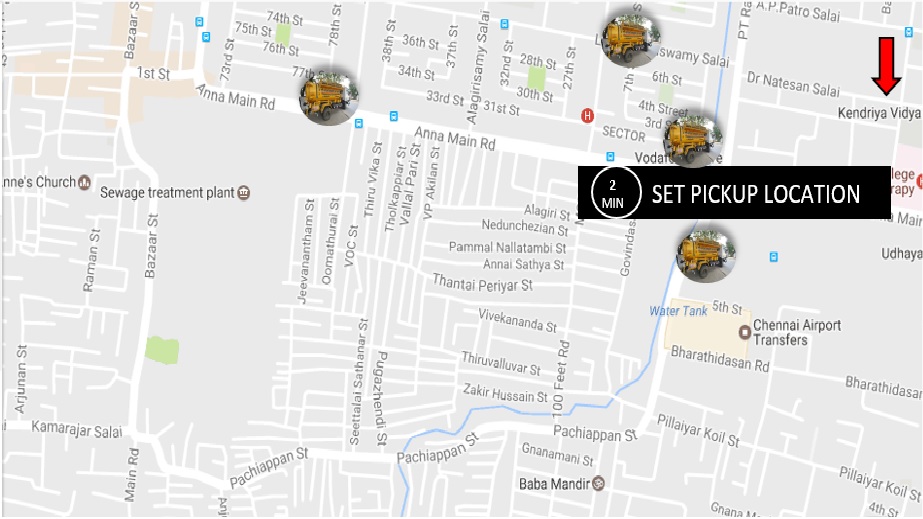Faecal sludge management or FSM is a management system that safely collects, transports, and treats faecal sludge (also called septage) from pit latrines, septic tanks or other onsite sanitation facilities (OSSF). One of the key components of faecal sludge management is the safe transportation of faecal sludge from the on-site sanitation facility to the point of treatment. There is no doubt that safe disposal of faecal sludge is the primary objective of any FSM project and the faecal sludge transporters play a key role in this process.
In faecal sludge transportation, different stakeholders are involved in the successful transfer of sludge from containment to the treatment facility. These stakeholders include households, service providers, sanitary workers, septage truck owners and officers from the Urban Local Body (ULB). However, it is commonly seen that these different stakeholders do not work in a coordinated fashion when it comes to transporting faecal sludge from households to a treatment facility. It is in this case that technology can come to the rescue.
At present, the existing system is not fully equipped for holding, retrieving and maintaining information on sanitation facilities including service provision. For example, no authorised body in the ULB has complete information on households (HHs) sanitation facility, faecal sludge containment and faecal sludge flow. This lack of information and communication will, in the long run, account for badly managed sanitation systems. In this scenario, it would be interesting if faecal sludge transportation followed a system like Uber or Ola cabs, using an application.
Let us examine this idea a little more closely. What do the residents want from any service? 
1. Reliability
2. Efficiency
3. Cost effectiveness.
All these three are available in the Uber and Ola Apps. These transport services are using mobile web-based GIS technology to provide real-time information about the vehicle, vehicle number, contact number and approximate cost (based on travel distance, total travel time and base fare). Once the service is complete, the customer is asked to rate the service for efficiency.
While this system can be easily adopted by the ULBs to reach customer locations as well as keep track of the septage trucks, the ULBs are wary about its misuse because once the mobile has been turned off or the app has been uninstalled, it is difficult to track the vehicle. However, if we keep in mind that the core aim is to provide customers with better services, and not just prevent illegal dumping of faecal sludge, these small lapses can be set right.
Learning from others
FSM projects in countries like Senegal have established the world’s first innovative call centre system to enable the customer to receive the best and the most economical service for desludging. This system operates on request-based desludging and not schedule-based desludging. The clients send their request for desludging to the call centre and the call centre contacts the operators near the said client’s location for quotations. The call centre then sends the lowest quotation to the client based on which the client asks the call centre to send a particular desludging vehicle. Once the desludging is completed, the call centre calls the client to check for customer satisfaction. This system works well but requires transparency at all levels to be sustainable in the long run.
The integration of GPS, GIS, GPRS and the mobile-based web application for ULB, service providers and residents will improve the quality of the service, are easy to monitor and ensure a safe environment. GPS will provide the current position, GIS will provide route directions and how to get there (simple algorithm for path finding using different aspects shortest path, regulated path and travel time), while GPRS will provide real time data, through the mobile towers.
If the FSM project needs to be successful, it should follow the improved service orientation approach and not just monitoring approach. If the sludge transport system has to run successfully for long periods, the process has to be transparent and should benefit both clients as well as the service providers. Towards this end, all stakeholders have to sit together and discuss the possibility of an improved service-oriented approach to creating a better environment for everyone to live in, and this approach should be facilitated by the ULBs.
This is one of a series of blog posts written by experts from the Tamil Nadu Urban Sanitation Support Programme (TNUSSP). The TNUSSP supports the Government of Tamil Nadu (GoTN) and select cities in making improvements along the entire urban sanitation value chain. The TNUSSP is being implemented by a consortium of organisations led by the Indian Institute for Human Settlements (IIHS), in association with CDD Society, Gramalaya and Keystone Foundation. You can find out more about TNUSSP at http://muzhusugadharam.co.in/tnussp/













